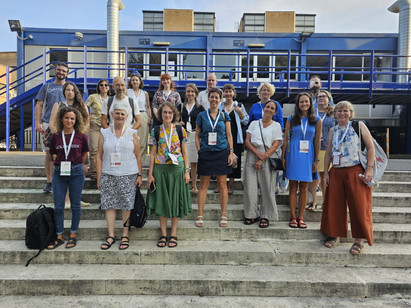As the year comes to an end, we want to share with you some highlights from the year. We have been out and about, all over Anatolia and beyond, looking at personal ornaments to uncover the stories they can tell about the embodied identities of the earliest sedentary communities in this part of the world. Of course, we did not only do scientific research. Our year was filled with travels to disseminate results from the project in festivals, seminars, workshops and conferences, and a podcast.
Let’s recap!
May 2024 was very busy for Emma, our project PI and National Geographic Explorer. She went to Bulgaria where she was invited by National Geographic to take part in a leadership training program, and also to give two presentations as part of the Sofia Science Festival. Presenting our findings to the public is one of our most important responsibilities, and something that requires a great deal of practice and skill to be able to do well. Opportunities like this are therefore very important for personal development as well as for sharing what we have done. She then gave two talks in Ankara, Türkiye at the Middle East Technical University (METU) and Bilkent University. Students are always keen to hear about research, especially when shared in an informal and relaxed environment. METU Archaeology Club has a great record of helping its members get an insight into archaeology with one of the most diverse and active memberships in Ankara. Emma presented about how we think about the ornamentation of the human body and how we go about studying that within the framework of archaeology. At Bilkent she presented on her years of research in the prehistory of ornamentation in Türkiye.
The summer season was even busier. We spent most of it in central Anatolia. Sera was in Cappadocia, Aksaray, throughout July and August, studying personal ornaments from two early Neolithic (9th-8th mill cal BC) sites, Asıklı and Balıklı, currently being excavated under the direction of Nurcan Kayacan and Günes Duru of Istanbul and Mimar Sinan Fine Arts Universities, and the Aksaray Museum. The bead assemblage is dominated by stone beads of various forms. Most of the stone beads display heavy use-wear and are associated with graves. Shells, abundant especially at Balıklı come from the Mediterranean Sea and also freshwater resources.
In the meantime, at the beginning of August Emma visited Karaman Museum and the dusty Konya plain to continue her study of the shell and stone beads from the Epipalaeolithic and Early Neolithic Pınarbaşı rock shelter, being excavated under the direction of Gökhan Mustafaoglu and Douglas Baird of Ankara Hacı Bayram Veli and Liverpool Universities. This site is a particularly important source of information about the earliest ornamentation practices in Anatolia as it was inhabited over many thousands of years starting from around 16,000 years ago and seems to have been a consistent source of fresh water for people travelling through central Anatolia (the name means ‘spring-head’ in English). The hunter-gatherers who camped in the area buried their dead with ornaments that have given us an unprecedented window onto individuals of the pre-Neolithic period.
Our workstation at the Asıklı excavation house with Coco waiting for us to finish work so that we can go out and play (left), view of the perforation tube of a broken and reused bead from Balıklı (right)
We then met in Cappadocia and drove towards Nigde. This mission was the start of a new study of personal ornaments from Sırçalıtepe, an early Neolithic site in Cappadocia located nearby the major obsidian sources, being excavated under the direction of Semra Balcı of Istanbul University.
Emma and Sera at the Nigde Museum, measuring and registering beads from Sırçalıtepe (left) and looking at a decorated bone object at the Nigde Museum-Istanbul University Archaeological Research Centre (middle), a unique ornament from Sırçalıtepe under the microscope
These study missions yielded new, exciting insights into the body ornamentation and identity-making practices of the early sedentary inhabitants of central Anatolia.
At the Nigde Museum-Istanbul University Archaeological Research Centre with the Sırçalıtepe Research Project team
In another news, we also started our pilot experimental project with experimental archaeologist Ulas Cumali joining us. Thanks to the hospitality of the Asıklı Research Project, we conducted our experimental studies in the open spaces and inside one of the replica houses belonging to the experimental Asıklı village that welcomes you at the entrance to the site. We documented the entire manufacturing process of a stone bead, employing prehistoric methods. Carefully recording each manufacturing step from coarse abrasion to drilling and final polishing processes, we had the chance to observe the difficulties and errors encountered during the process. This pilot study brought us one more step closer to understanding prehistoric beadmakers and how they organised technological processes.
A bead preform after coarse abrasion with a grinding slab (left), coarse abrasion with a hand-held tool (middle), the final product (right)
We also continue disseminating the results of our ongoing work. Our chapter titled ‘Bodies and behaviours: archaeological material culture and the interpretation of identity at the Neolithic transition’ will soon appear in an edited volume published by Springer. In this contribution we used a conspectus of research on Neolithic body-artefact relations to ask what theoretical and interpretive frameworks have been employed to approach the question of identities as seen in the available archaeological record. With a critical lens, we looked at current data on personal ornaments and their portrayal in various media in proximity to the human body and discussed how much we know about how the materiality and communication of identity evolved through time, which areas of evidence have not yet been explored to their full potential, and where the limits of interpretation should lie. Keep an eye here for the publication!
In late August, we flew to Rome to share results from the project at the European Association of Archaeologists (EAA) Annual Meeting. There, with colleagues from all around the world, we organized a session titled ‘Embodied identities: unravelling symbolic threads through ornaments, garments, and portable objects’. This session offered offering a panoramic view of the social significance of personal ornaments, small, portable, symbolic objects, and body decoration across diverse periods and places. Spanning from prehistoric Eurasia to the Americas, the presented papers included studies on beads, incised symbolic objects, grave goods, and permanent body modifications like tattooing.
Banner of our session at the EAA (left) and the session organisers and participants after the end of the day (right)
The summer season came to an end with two trips to new sites. Visiting new sites and looking at new artefacts is part of our ongoing learning process. It is only through accumulating knowledge of what happened in different places in the past that we can build a picture of larger patterns and relationships. Emma paid a preliminary visit to Balıkesir İnboğazı Andık Cave, being excavated under the direction of Derya Yalçıklı of Çanakkale University, which is beginning to yield some fascinating Chalcolithic and Neolithic contexts indicating long-lived use of the cave for both habitation and a variety of production activities. A completely new and contrasting experience was offered by the site of Svinjarička Čuka in southern Serbia where Emma was excited to be invited by Barbara Horejs of the Austrian Archaeological Institute to study the beads of the Neolithic cultures of this region. The materials are significantly different to what we are used to in western Asia, although with some influences from the later Neolithic of the Aegean region that are also very familiar. Both these sites offer excellent prospects for future study.
And later in October, we were in Barcelona! In the sunny and warm Autumn of this wonderful city, we attended the ‘Social Interactions in Mediterranean Prehistory / SIMEP2024’ conference organised by the ‘Archaeology of Social Dynamics’ Research Group of the Spanish National Research Council (CSIC-IMF, Barcelona). We presented some insights from the project in two different sessions focusing on alterity and identities, and circulation, exchange and trade. In the beautiful atmosphere of Barcelona, we had the chance to, again, meet and have very exciting, fruitful discussions about our research with lovely colleagues from all over the world.
The people that we work with are extremely important. Finding synergy with colleagues that allows us to be both productive and creative is one of the most fundamental aspects of our work, and the source of real professional success. In this case Emma was very happy for her final trip of the year to be able to get together in Vienna with colleagues who had been working together on another project called ARROWFUNC, directed by Bogdana Milic, about the use of stone arrows in prehistoric contexts in southwest Asia. This gave her an opportunity to share some of the ‘Small things, big stories’ research with archaeologists also working on the micro-detail of prehistoric material culture and find some shared practices like recycling that will need further investigation in future research.
The final event of the year offers a lasting legacy for our project. The British Institute at Ankara was set up in the 1950s to facilitate archaeological exploration in the young Turkish Republic. Since then, its mission has transformed dramatically, and it is now a multidisciplinary centre for research on many aspects of Turkish history and culture. As part of its ongoing work a new podcast series explores the research work of those with ties to the Institute. As a former Fellow of the Institute, Emma was invited to be a guest on the podcast and explain the importance of our work in the ‘Small things, big stories’ project. You can find the podcast here: https://youtu.be/fvgJPUJn37A?feature=shared or at any of the usual podcast venues.






















